Exercises (3201)
Tennis: technique training
Forms of play / exercises
Exercises with a throw-off or lead-off by the leader are suitable for technical aspects of training.
Teaching the forehand and backhand technique:
Exercise 1: the player drops balls and the leader holds the player's racket, so the player has to take a high loop, swing under the leader's racket and hit the ball to the other side.
Exercise 2: as above, but the leader leaves the racket as an aid and drops the balls again.
Exercise 3: the leader passes balls to the player, who must perform the same stroke sequence from the movement to the ball.
Exercise 4: the leader plays from the opposite side with the racket and the player performs the same stroke sequence (further distance).
Per participant:
1 tennis racket
x tennis balls
Test form
Interval training
Individual work
The participants are independently responsible for the evaluation of their test!
Exercise duration: 2 minutes
Pause: 2 minutes and 30 seconds
Repeats: 4 times
Intensity level: 4 (hard)
Max HR: 90-95%
Rule of speech: brief exchange of words
In this type of test, it is important that the participants try to cover the same distance in the specified time for each interval.
The test form can be carried out as follows:
- Round track: To ensure that the participants have enough space available for the run, they can be spread out on the round track at the start. The load starts from the same starting point for each individual runner for each repetition. During the breaks, the participants return to their starting point. This allows participants to check/calculate the distance travelled after each interval. The sports director has all participants in view and can therefore start or stop the intervals with a signal.
- Distance of at least 700 metres: Distances are marked with signs (every 25-50 metres). Each participant receives a stop/pulse watch, runs the course independently and memorises the distance covered (it is possible to stagger the start of the participants). After the break time has elapsed, the participants run the distance they ran back to the starting point. During the breaks, the participants wait in place or continue running at a relaxed trot, but return to the starting point in good time (end of the previous interval). If the course allows, the sports director can give the start/stop signal for all participants (no staggering possible).
Variant: If you only have a short course available, you must turn around at the end of the course and continue running in the opposite direction until the end of the load time. At the next interval, the participants run the distance they ran earlier in the opposite direction back to the starting point. - Longer-distance circuit: The distances are marked with signs (every 25-50 metres). Each participant receives a stop/pulse watch, runs the course independently and calculates the distance travelled (no staggered start of the participants necessary). During the breaks, the participants wait in place or continue running at a relaxed trot until the end of the break time. For each interval, the participants must calculate the distance travelled based on the start/end point of the interval. After the last interval, all runners return to the starting point, which takes additional time.
After each interval, participants either have the option of writing down the distance covered (writing materials available on the track or on Mann) or memorising the four distances to write them down at the end of the test. The distances covered per interval are noted and totalled.
To evaluate the test, the distances covered for the four intervals are totalled. The result is noted down and can be compared with the next test. It is also worth dividing the result by the number of intervals (4) so that you have a comparative value for the individual intervals for the next test.
Distance markers (signs with metres)
1 signalling device (e.g. whistle)
For each participant:
1 heart rate monitor
For the sports director or each participant:
1 stopwatch
Writing materials and notepad
TicTacToe relay
Increase pulse
Group work
2 groups of 4-5 participants each
Change the order of participants after each round
The hoops are placed on the ground at a certain distance (approx. 10-15 metres) in front of the two groups in a square (3x3). Each group has three bibs, which they can distribute in the hoops. One bib may be carried per run. If a group manages to distribute the bibs in a row (horizontally, vertically or diagonally) in the hoops, they win the game. If a group has placed the three bibs in the hoops but the game has not yet been decided, the next runner can move a bib that is already in place to continue the game and, if necessary, decide in their favour.
Pitch:
9 hoops (optional: 4 ropes to mark the pitches)
Per group:
3 bibs (or 3 identical items such as IVP, bag knife)
1 hat
TicTacToe relay
Increase pulse
Group work
2 groups of 4-5 participants each
Change the order of participants after each round
The hoops are placed on the ground at a certain distance (approx. 10-15 metres) in front of the two groups in a square (3x3). Each group has three balls, which they can distribute into the hoops. One ball may be carried per run (carrying the ball in the hands, bouncing it or guiding it with the foot, balancing the ball/shuttle on the stick, guiding the ball with the stick). If a group manages to distribute the balls in a row (horizontally, vertically or diagonally) in the hoop, they win the game. If a group has deposited the three balls in the hoops but the game has not yet been decided, the next runner can move a ball that is already in the hoop to continue the game and, if necessary, decide in their favour.
Pitch:
9 hoops (optional: 4 ropes to mark the pitches)
Per group:
1 cone
1 ball ►baseball, futsal/football, handball, FooBaSKILL, volleyball
1 stick ►unihockey, intercrosse/lacrosse, Nordic walking
1 racket ►badminton/speedminton, smolball
TicTacToe relay
Forms of play / exercises
Group work
2 groups of 4-5 participants each
Change the order of participants after each round
The hoops are placed on the ground at a certain distance (approx. 10-15 metres) in front of the two groups in a square (3x3). Each group has three bibs, which they can distribute in the hoops. One bib may be carried per run. If a group manages to distribute the bibs in a row (horizontally, vertically or diagonally) in the hoops, they win the game. If a group has deposited the three bibs in the hoops, but the game has not yet been decided, the next runner can move a bib (of their own colour) that is already in place to continue the game and possibly win it.
Pitch:
9 hoops (optional: 4 ropes to mark the pitches)
Per group:
3 bibs (or 3 identical items such as marking hats, IVP, bag knife)
1 colouring stick
Tiger ball
Stimulate circulation
Group work
5-8 participants per group
In a limited playing field, the game is played 4:1, 5:1, 5:2 or 6:2, for example. The "tiger" in the centre chases the ball/throwing disc, while the outside players pass the ball/throwing disc to each other (with their hands, feet or playing equipment, depending on the type of game). If the "tiger" touches the ball/throwing disc or an outfield player makes a mistake (e.g. ball/throwing disc leaves the playing field or falls to the ground after a pass), the roles of the "tiger" and the person responsible for the mistake are swapped.
Per participant:
1 bat/stick ►smolball, floorball, intercrosse/lacrosse
1 ball/throwing disc (frisbee) ►basketball, blitzball/rugby/football, FooBaSKILL, futsal/football, handball, intercrosse/lacrosse, smolball, floorball, Frisbee Ulitmate
4 marking cones/caps ►field markings
Table tennis: Game
Forms of play / exercises
Group work

Single (group of 2) or double game (group of 4) to a winning set (11 points). If the group size is uneven (e.g. 3 participants), one player enjoys a break, whereby the set duration is reduced to 7 points to shorten the waiting times.
Additional strengthening task:
After each set, the loser completes a strength exercise: 5x squat plus jump squat
1 table tennis table
2-4 table tennis bats
x table tennis balls
Goalball
Increase pulse
Group work
2 teams
Two teams play against each other on a limited playing field. Several goals are set up using markers (e.g. colouring sticks, marker cones or cones) (ideally more goals than opponents). The team with the ball tries to pass the ball between the goals as often as possible (double passes are not allowed to score goals). The ball must be caught/received by a team-mate behind the goal. If the opposing team captures the ball, they can try to score goals.
16 colouring sticks
1 handball
x bibs
Goalball
Increase pulse
Group work
2 teams
Two teams play against each other on a limited playing field. Several goals are set up using markers (e.g. colouring sticks, marker cones or cones) (ideally more goals than opponents). The team with the ball tries to pass the ball between the goals as often as possible (double passes are not allowed to score goals). The ball must be received behind the goal by a team-mate with a floorball stick. If the opposing team captures the ball, they can try to score goals.
16 colouring sticks
1 floorball
x bibs
Participant:
1 floorball stick
Goalball
Increase pulse
Group work
2 teams
Two teams play against each other on a limited playing field. Several goals are set up using markers (e.g. colouring sticks, marker cones or cones) (ideally more goals than opponents). The team with the ball tries to pass the ball between the goals as often as possible (double passes are not allowed to score goals). The ball must be caught/received by a team-mate behind the goal. If the opposing team captures the ball, they can try to score goals.
The following rules apply to the game form:
- The ball, which is balanced on the stick, may be carried a maximum of 4 steps and must then be passed immediately.
- The ball may be touched a maximum of 4 times before it is played on.
- The ball at rest on the stick, without movement of the player, may be held for a maximum of 4 seconds.
- The ball may not be covered with the racket or the body, but must be played on immediately.
- It is not permitted to actively play the ball with the foot or lower leg, with the hand, the arm or the head (free hit).
If the ball leaves the playing field, it is brought back into play by a free hit by the opposing team at the place of action.
16 colouring sticks
1 smolball
x bibs
Per participant:
1 smolball bat
Torfrisbee
Increase pulse
Group work
2 teams
Two teams play against each other on a limited playing field. Several goals are set up using markers (e.g. colouring sticks, marking cones or cones) (ideally more goals than opponents). The team with the frisbee tries to pass the disc between the goals as often as possible (double passes are not allowed to score goals). The frisbee must be caught by a team-mate behind the goal. If the opposing team captures the frisbee, they can try to score goals.
16 colouring sticks
1 frisbee
x bibs
Transport relay
Increase pulse
Group work
4-6 participants per group
Each group receives two small mats. The group must now cover a certain distance without touching the floor. In other words, the whole group stands on one mat and the person at the back of the group passes the free mat to the front. The free mat is placed in front of the mat occupied by the participants so that all participants can move onto it without touching the floor. The free mat is then moved forwards.
The group moves in this way until it reaches the turning point (both mats have passed the colouring stick). If a participant touches the ground on the way, the whole group must return to the starting point and start the course all over again. If the course is successfully completed, one person is transported on the mat on the way back.
It is important to remember that the second mat must also be transported back to the start; the group can transport one person on both mats or the second mat can be carried back separately.
The relay form is repeated until every participant in the group has been transported once on a mat (or define a certain number of participants for the transport due to the time conditions).
In the field, committee tents can be used instead of mats.
Per group:
2 painting sticks
2 soft mats (small)
In the grounds:
2 committee tents
Tunnelball
Stimulate circulation
Group work
6-8 participants per group

All participants except the front and back of the group lie down parallel in a row (facing the floor). There is a distance of one to two metres between the participants. The participant at the beginning of the chain has a ball at the start. On his or her command, the lying participants move into the push-up position and form a tunnel. The participant in front rolls the ball through the tunnel and then lies down in the row. On the other side of the tunnel, the ball is caught by the second standing participant (last in the row). The latter then hops over the participants who are lying down again and then rolls the ball through the tunnel. The last participant in the row becomes the new ball catcher. If the thrower does not roll the ball correctly through the tunnel or it does not reach the catcher, the attempt must be repeated (as often as necessary until it works).
Possible competition format: The winner is the group in which all participants have first rolled the ball through the tunnel once (or several times) and the whole group is back in a standing position.
Per group:
1 ball (e.g. basketball, softball, football, volleyball, medicine ball)
dodge ball
Stimulate circulation
Group work
2 groups
One group adjusts the ball/disc in a defined playing field so that they can touch a participant from the other group with the ball/disc ("dabbing", without throwing). You are not allowed to move with the ball/disc (maximum star step). Each "dab", or when a chased player leaves the playing field, results in a point. Which group collects more points in a given time?
Variant I:
If a participant touches the ball/disc, they are eliminated from the game (they may have to perform an additional task, such as remaining in a forearm support position). The sports leader times how long it takes for the entire group to be eliminated.
Variant II:
2-3 catchers try to touch the other participants with the ball/throwing disc (no throwing). Anyone touched by a catcher is eliminated and performs an additional task (e.g. 20 push-ups or trunk bends) and then takes part in the game again. The catchers are changed regularly
1 ball/throwing disc ►Basketball, Frisbee Ultimate, FooBaSKILL, Futsal/Football, Handball, Tchoukball
One group:
x game ribbons/bibs ►team identification
Sports leader:
1 stopwatch
Twister I
Parkour
Individual work
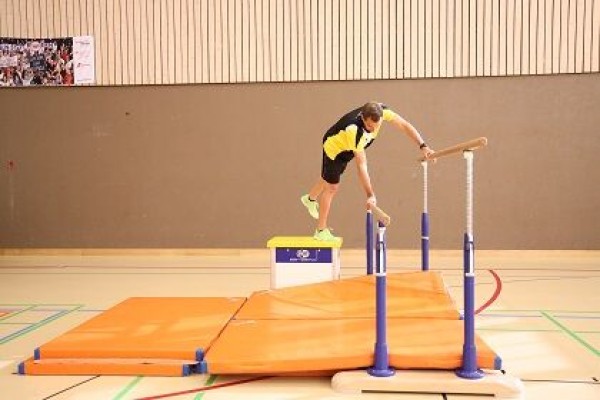
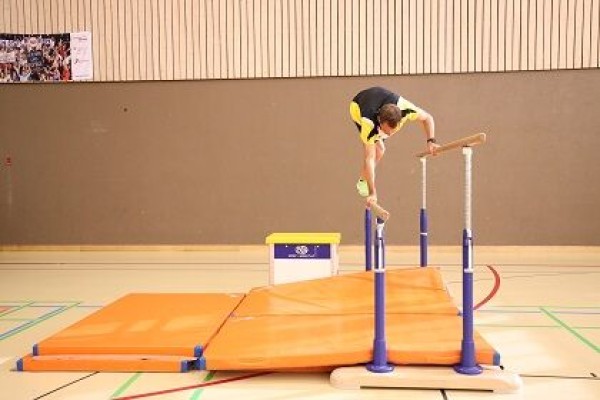

Climb onto the low bars of the uneven bars via the vaulting box, hold onto both bars with your hands, drop your legs between the two bars into the support, swing your legs forwards and jump off the uneven bars over the low bars, landing with both legs on a soft mat next to the uneven bars.
1 bar
1 vaulting box
4-5 soft mats (small)
Post setup:
Fix the uprights of a bar at different heights (height difference approx. 30-50cm), place a vaulting box in front of the bar (3-4 elements), lay out soft mats underneath
.
Twister II
Parkour
Individual work
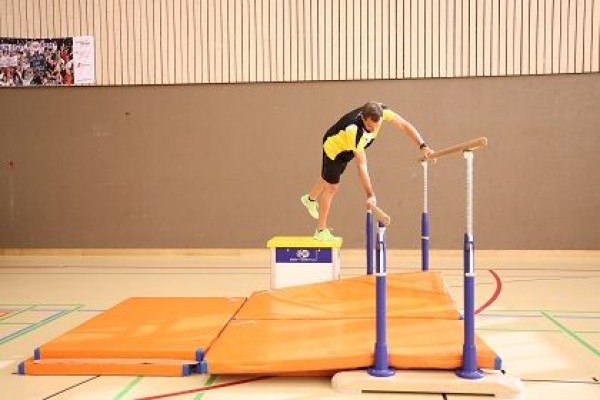
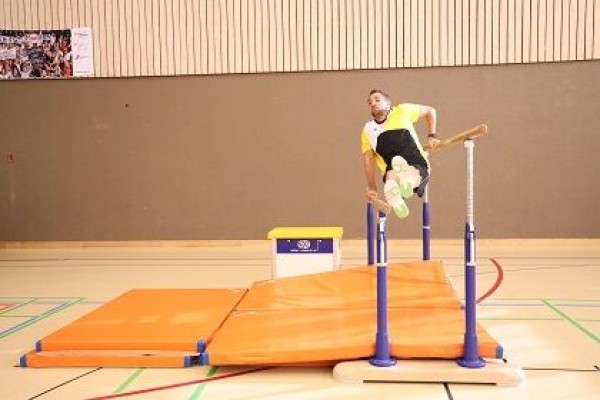

Stand on the vaulting box, hold on to both bars with your hands, jump with both legs into the support between the two bars, swing your legs forwards and jump off the uneven bars over the low bars, landing with both legs on a soft mat next to the uneven bars.
1 bar
1 vaulting box
4-5 soft mats (small)
Post setup:
Fix the uprights of a bar at different heights (height difference approx. 30-50cm), place a vaulting box in front of the bar (3-4 elements), lay out soft mats underneath
.
Twister III
Parkour
Individual work

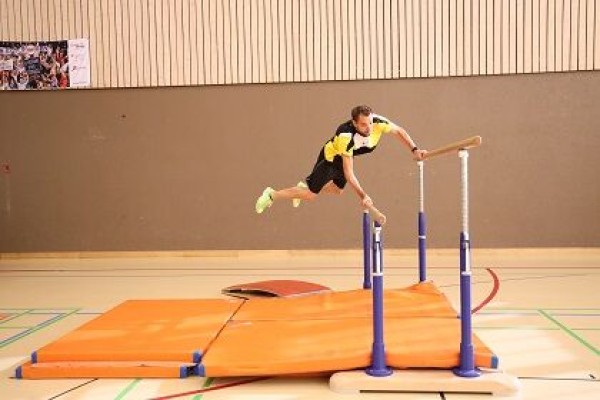

Short run-up, two-legged jump from the Reuter board into the support between the two bars of the uneven bars, swing the legs forwards and jump off the uneven bars over the low bars, landing with both legs on a soft mat next to the uneven bars.
1 bar
1 Reuter board
4-5 soft mats (small)
Post setup:
Fix the uprights of a bar at different heights (height difference approx. 30-50cm), place a Reuter board in front of the bar, lay out soft mats underneath
Twister IV
Parkour
Individual work
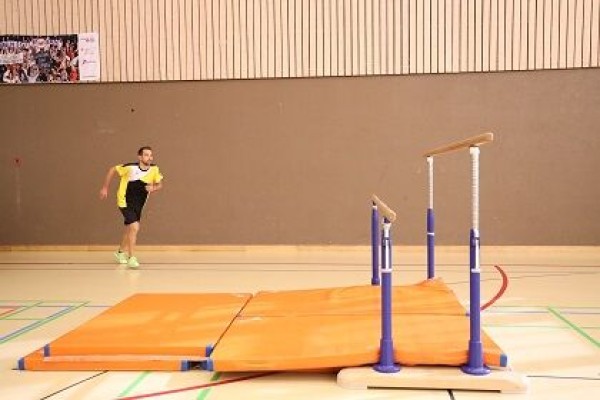
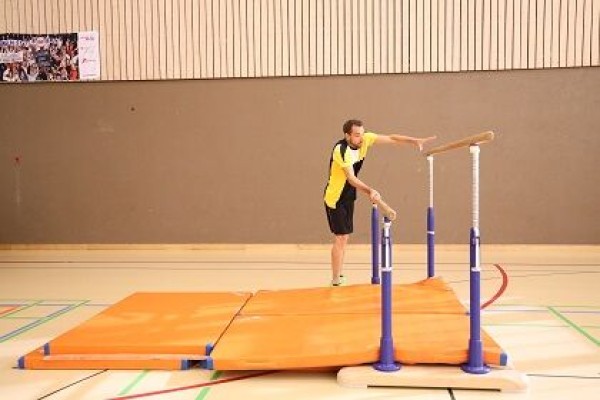
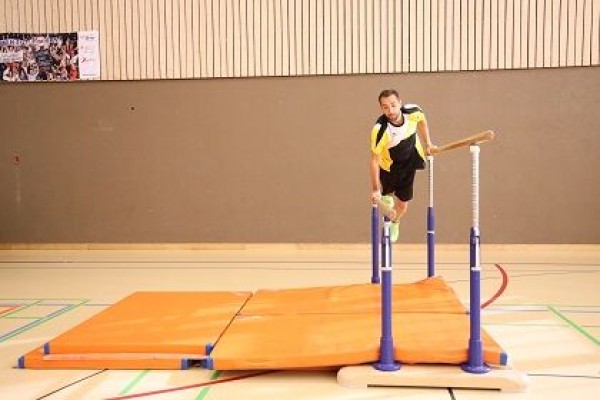
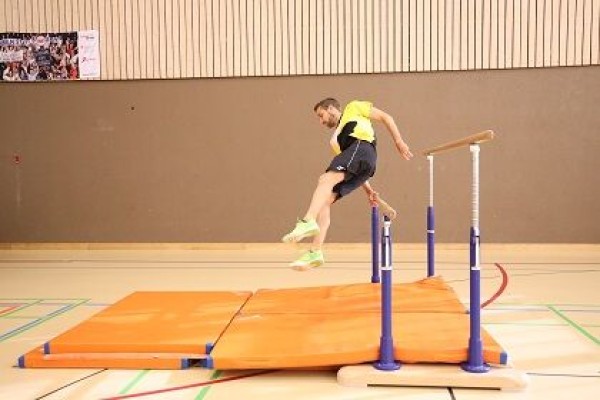
Short run-up, two-legged jump into the support between the two bars of the uneven bars, swing legs forwards and jump off the uneven bars over the low bars, two-legged landing next to the bars.
1 bar
Post set-up:
Fix the uprights of the bar at different heights (height difference approx. 30-50cm).
Skip
Power
Individual work

Round race with (3) obstacles (e.g. hurdles or a rope stretched between two stakes). The aim is to jump over the obstacles.
Attention:
Suspend the landing with your legs (lower your buttocks).
Lighten:
Lower obstacles.
Harden:
Higher obstacles.
Variant:
Jump up again immediately after landing (explosive power) or take a roughly right angle with your knees when landing and hold this position briefly before jumping off again.
2 stakes/1 rope or 1 hurdle = 1 obstacle
Alternating skipping and crawling under
Power
Individual work


Round course with (2) obstacles (e.g. hurdles or a rope stretched between two stakes). The aim is to alternately jump over and crawl under the obstacle once.
Attention:
Suspend the landing.
Lighten:
Lower speed; lower obstacle for jumping over; higher obstacle for crawling under.
Harden:
Higher speed; higher obstacle for jumping over; lower obstacle for crawling under.
2 stakes/1 rope or 1 hurdle = 1 obstacle
2 marking cones/caps
Alternating skipping and crawling under
Power
Individual work


Round course with various obstacles: The horse/swinging box is jumped over, at the single swinging box element you crawl/crawl through the opening.
Lighten:
Lower speed; lower elements to jump over/higher elements to crawl under.
Harden:
Higher speed; higher elements to jump over/lower elements to crawl under.
1-2 pommel horses
1-2 vaulting boxes
or instead of pommel horses and vaulting boxes, skipping ropes can be stretched between two painting sticks at different heights for jumping over/crawling under
4-8 painting sticks
2-4 ropes
3-6 soft mats (small)
2 painting sticks (optionally as a reversible pole)
Overcoming an obstacle
Power
Individual work
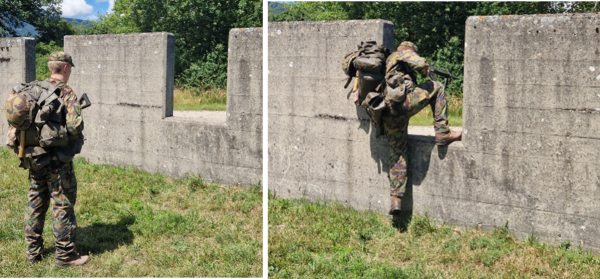
Overcoming a wall or opening using house and location fighting techniques (regulation 53.008.01 - chapter 6.3).
Lighten:
Without equipment;
Less high wall;
Without opening.
Harden:
With a protective waistcoat;
Higher wall.
Material per participant: Tenue CNK 420
Additional material: small wall/ruins, 1 protective vest
Overcoming an obstacle I (ventral franchissement)
Parkour
Individual work

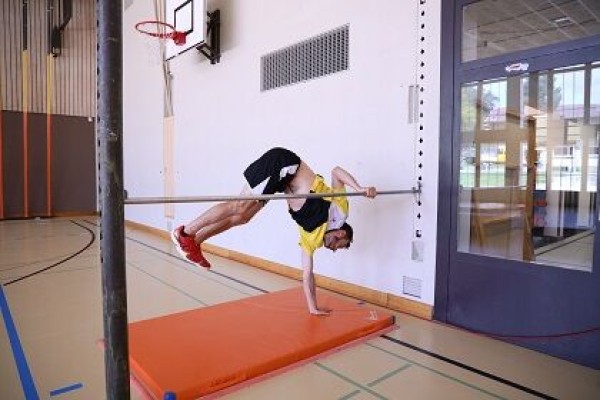
Stand frontally to the (horizontal) bar, hips leaning against the (horizontal) bar, bend the upper body over the bar and support one arm on the opposite side on the soft mat/floor, hold on to the (horizontal) bar with the other hand next to the hip in an underhand grip, now swing the legs vertically over the horizontal bar in an arching movement to land on the feet.
1 (horizontal) bar
1 soft mat (small) ► Indoor version
Indoor post setup:
Fix a horizontal bar at hip height and place a soft mat underneath.
Outdoor:
A bar or similar at approx. hip height.
Overcoming an obstacle II (abdominal turn)
Parkour
Individual work
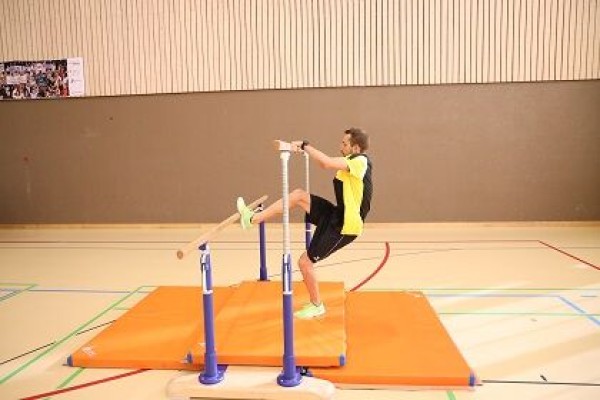

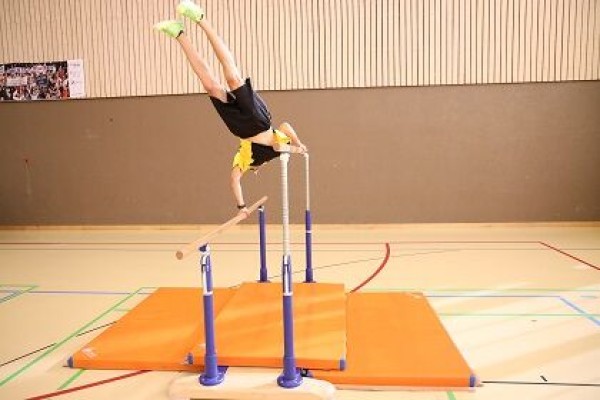
Support with both arms on the high bar, one hand grips the low bar (lean upper body forwards), the other hand still holds on to the upper bar next to the hips, now swing the legs vertically over the upper bar in an arching movement, landing in a standing position next to the bar on a soft mat.
1 parallel bars
4 soft mats (small)
Post setup:
Adjust the height of the parallel bars so that there is a height difference of approx. 50 cm. Lay out several soft mats under the parallel bars.
Overcoming an obstacle III (abdominal turn)
Parkour
Individual work

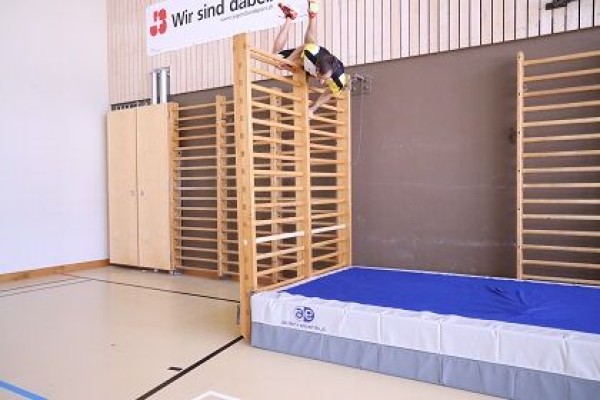

Stand on the wall bars, support yourself with both arms on the top rung with an underhand grip, and press your hips against that rung, bend your upper body over the wall bars and grab a rung as low as possible with one hand, now swing your legs vertically over the wall bars in an arching movement, landing in a standing position on the soft mat.
1 wall bars
1 soft mat (large)
Post assembly:
Loosen the wall bars and attach them at a 90 degree angle to the wall, place a large soft mat behind them.